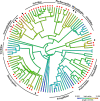Evolution of winter molting strategies in European and North American migratory passerines
- PMID: 34646466
- PMCID: PMC8495808
- DOI: 10.1002/ece3.8047
Evolution of winter molting strategies in European and North American migratory passerines
Abstract
Molt is critical for birds as it replaces damaged feathers and worn plumage, enhancing flight performance, thermoregulation, and communication. In passerines, molt generally occurs on the breeding grounds during the postbreeding period once a year. However, some species of migrant passerines that breed in the Nearctic and Western Palearctic regions have evolved different molting strategies that involve molting on the overwintering grounds. Some species forego molt on the breeding grounds and instead complete their prebasic molt on the overwintering grounds. Other species molt some or all feathers a second time (prealternate molt) during the overwintering period. Using phylogenetic analyses, we explored the potential drivers of the evolution of winter molts in Nearctic and Western Palearctic breeding passerines. Our results indicate an association between longer photoperiods and the presence of prebasic and prealternate molts on the overwintering grounds for both Nearctic and Western Palearctic species. We also found a relationship between prealternate molt and generalist and water habitats for Western Palearctic species. Finally, the complete prealternate molt in Western Palearctic passerines was linked to longer days on the overwintering grounds and longer migration distance. Longer days may favor the evolution of winter prebasic molt by increasing the time window when birds can absorb essential nutrients for molt. Alternatively, for birds undertaking a prealternate molt at the end of the overwintering period, longer days may increase exposure to feather-degrading ultra-violet radiation, necessitating the replacement of feathers. Our study underlines the importance of the overwintering grounds in the critical process of molt for many passerines that breed in the Nearctic and Western Palearctic regions.
Keywords: Nearctic; Passeriformes; Western Palearctic; molt; phylogenetic analysis.
© 2021 The Authors. Ecology and Evolution published by John Wiley & Sons Ltd.
Conflict of interest statement
We declare we have no conflict of interests.
Figures



References
-
- AppEEARS Team (2019). Application for Extracting and Exploring Analysis Ready Samples (AppEEARS). Ver. 2.30. NASA EOSDIS Land Processes Distributed Active Archive Center (LP DAAC), USGS/Earth Resources Observation and Science (EROS) Center. https://lpdaacsvc.cr.usgs.gov/appeears
-
- Bergman, G. (1982). Why are the wings of larus fuscus fuscus so dark? Ornis Fennica, 59, 77–83.
-
- BirdLife International (2018). Data zone. http://datazone.birdlife.org/home
-
- BirdLife International and Handbook of the Birds of the World (2018). Bird species distribution maps of the world. Version 2018.1. http://datazone.birdlife.org/species/requestdis
Associated data
LinkOut - more resources
Full Text Sources

